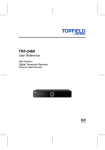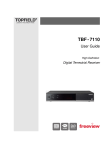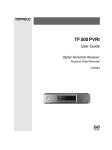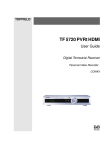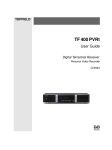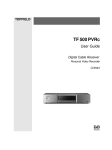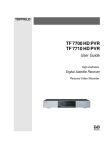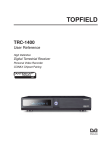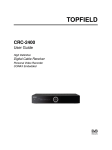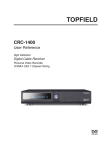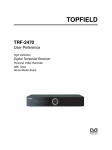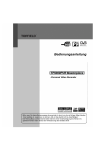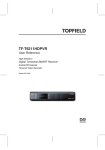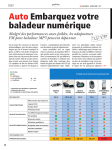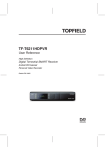Download User guide for TF7100HDPVRtPlus
Transcript
Digital Terrestrial Receiver Personal Video Recorder TF7100HDPVRt Plus User Guide Macrovision This product incorporates copyright protection technology that is protected by U.S. patents and other intellectual property rights. Use of this copyright protection technology must be authorized by Macrovision, and is intended for home and other limited viewing uses only unless otherwise authorized by Macrovision. Reverse engineering or disassembly is prohibited. The lightning flash with arrowhead symbol, within an equilateral triangle, is intended to alert the user to the presence of uninsulated “dangerous voltage” within the product’s enclosure that may be of sufficient magnitude to constitute a risk of electric shock to a person. The exclamation point, within an equilateral triangle, is intended to alert the user to the presence of important operating and maintenance (servicing) instructions in the literature accompanying the product. iv CONTENTS Contents Contents 1 2 3 4 Introduction 1.1 Features . . . . . . . . . . . . . 1.2 Controlling the digital receiver 1.2.1 The front panel . . . . . 1.2.2 The remote control . . . iv . . . . . . . . . . . . . . . . . . . . . . . . . . . . . . . . . . . . . . . . . . . . . . . . . . . . 1 2 3 4 5 Setup 2.1 Unpacking . . . . . . . . . . . . . . . . . . 2.2 Safety precautions . . . . . . . . . . . . . 2.3 Rear panel connections . . . . . . . . . . . 2.4 Connecting up your digital receiver . . . 2.4.1 Connecting the antenna . . . . . . 2.4.2 Connecting to your television set 2.5 Inserting batteries in the remote control . 2.6 Switching on for the first time . . . . . . . . . . . . . . . . . . . . . . . . . . . . . . . . . . . . . . . . . . . . . . . . . . . . . . . . . . . . . . . . . . . . . . . . . . . . . . . . . . . . . . . . . . . . . . . . . . . . . . . 8 8 8 10 12 12 12 14 15 Service Search 3.1 Searching broadcasting services . 3.2 Resetting to factory settings . . . 3.3 Resetting to user settings . . . . . 3.4 Clearing the services list . . . . . . . . . . . . . . . . . . . . . . . . . . . . . . . . . . . . . . . . . . . . . . . . . . . . . 16 16 17 18 18 Preference Settings . . . . . . . . . . . . . . . . . . . . . . . . . . . . . . . . . . . . . . . . 20 CONTENTS 4.1 . . . . . . . . . . . . . . . . . . . . . . . . . . . . . . . . . . . . . . . . . . . . . . . . . . . . . . . . . . . . . . . . . . . . . . . . . . . . . . . . . . . . . . . . . . . . . . . . . . . . . . . . . . . . . . . . . . . . . . . . . . . . . . . . . . . . . . . . . . . . . . . . . . . . . . . . . . . . 20 20 21 22 23 25 27 28 29 30 30 31 Daily Usage 5.1 Volume control . . . . . . . . . . . . . . . 5.2 Watching television . . . . . . . . . . . . . 5.2.1 The services list . . . . . . . . . . . 5.2.2 The favourite services list . . . . . 5.2.3 Viewing programme information 5.2.4 Selecting audio tracks . . . . . . . 5.2.5 Selecting subtitle tracks . . . . . . 5.2.6 Viewing teletext . . . . . . . . . . 5.3 Viewing electronic programme guide . . 5.4 Watching multifeed programme . . . . . 5.5 Using time shift . . . . . . . . . . . . . . . . . . . . . . . . . . . . . . . . . . . . . . . . . . . . . . . . . . . . . . . . . . . . . . . . . . . . . . . . . . . . . . . . . . . . . . . . . . . . . . . . . . . . . . . . . . . . . . . . . . . . . . . . . . . . . . . . . . . . . . . . . . . . . . . . . . . 32 32 32 32 34 35 36 36 36 37 37 38 4.2 4.3 4.4 4.5 4.6 4.7 4.8 4.9 5 Video and audio settings . . . . . 4.1.1 High definition television 4.1.2 Television aspect ratio . . 4.1.3 Audio mode . . . . . . . Local time setting . . . . . . . . . Parental control . . . . . . . . . . Recording Settings . . . . . . . . Playback Settings . . . . . . . . . Adjusting the On-Screen Display Front Display Settings . . . . . . To use IceLINK . . . . . . . . . . Other Settings . . . . . . . . . . . . . . . . . . . . . . . . . . . . . . . . . . . . . . . . . . . . . . . . . . . . . . . . . . . v 6 Editing Services 40 6.1 Editing the favourite list . . . . . . . . . . . . . . . . . . . . . . 40 6.2 How to use the on-screen keyboard . . . . . . . . . . . . . . . 42 7 Recording and Playing 7.1 Recording a programme . . . . . . . . . . . . . . . . . . . . 7.1.1 Instant recording . . . . . . . . . . . . . . . . . . . . 7.1.2 Recording Reservation . . . . . . . . . . . . . . . . 7.1.3 Scheduling recordings using the programme guide 7.1.4 Recording a time-shifted programme . . . . . . . . . . . . . . . . . . 43 44 44 46 49 49 vi CONTENTS 7.2 . . . . . . . . . . . . . . . . . . . . . . . . . . . . . . . . . . . . . . . . . . . . . . . . . . . . . . . . . . . . . . . . . . . . . . . . . . . . . . . . . . . . . . . . . . . . . . . . . . . . . . 50 50 51 51 51 52 52 52 53 54 54 54 55 55 56 57 57 Special Features 8.1 Playing back MP3 files . . . . . . . . . . . . . . . . . . 8.2 Playing back video files . . . . . . . . . . . . . . . . . 8.3 Viewing graphic files . . . . . . . . . . . . . . . . . . . 8.4 Copying files . . . . . . . . . . . . . . . . . . . . . . . 8.4.1 To copy a file to an external hard disk drive . 8.4.2 To copy a file from an external hard disk drive 8.5 Weather . . . . . . . . . . . . . . . . . . . . . . . . . . 8.6 Network Game . . . . . . . . . . . . . . . . . . . . . . 8.6.1 Battle Tank Single Mode . . . . . . . . . . . . . 8.6.2 Battle Tank Network Mode . . . . . . . . . . . . . . . . . . . . . . . . . . . . . . . . . . . . . . . . . . . . . . . . . . . . . . . . . . . . . 58 58 59 60 60 60 61 61 62 62 67 Accessing to The Digital Receiver via The Internet 9.1 Configuring the router . . . . . . . . . . . . . . . . . . . . 9.1.1 To access within the local area network . . . . . . 9.1.2 To access over the Internet . . . . . . . . . . . . . 9.2 Configuring the network settings on the digital receiver . 9.2.1 Making a network profile . . . . . . . . . . . . . . . . . . . . . . . . . . . . . 68 69 69 70 71 72 7.3 7.4 7.5 7.6 8 9 File archive . . . . . . . . . . . . . . . . . . . 7.2.1 To delete a recording . . . . . . . . . . 7.2.2 To sort recordings . . . . . . . . . . . 7.2.3 To lock a recording . . . . . . . . . . . 7.2.4 To rename a recording . . . . . . . . . 7.2.5 To make a new folder . . . . . . . . . 7.2.6 To move a recording to another folder Playing back a recording . . . . . . . . . . . . 7.3.1 To navigate using the progress bar . . 7.3.2 To play in slow motion . . . . . . . . 7.3.3 To play in fast motion . . . . . . . . . 7.3.4 To make a bookmark . . . . . . . . . . 7.3.5 To play back a recording repeatedly . 7.3.6 To play back recordings in sequence . Editing a recording . . . . . . . . . . . . . . . Copying a recording . . . . . . . . . . . . . . Formatting the hard disk . . . . . . . . . . . . . . . . . . . . . . . . . . . . . . . . . . . . . . . . . . . . . . . . . . . . . . . . . . . . . . . . . . . . . . . . . . . . . . . . CONTENTS 9.3 9.4 vii Accessing the web server . . . . . . . . . . . . . . . . . . . . . 73 Accessing the FTP server . . . . . . . . . . . . . . . . . . . . . . 75 10 Firmware Update 10.1 Checking the firmware information . . . . . . . . . . . . . . . 10.2 From a USB memory . . . . . . . . . . . . . . . . . . . . . . . . 10.3 From the firmware server via the network . . . . . . . . . . . . 78 78 79 79 Index 81 1 Chapter 1 1 Introduction Congratulations on buying a TF 7100 HD PVRt Plus. The TF 7100 HD PVRt Plus allows you to view and record digital TV programmes easily. And the TF 7100 HD PVRt Plus digital receiver is fully compliant with the international Digital Video Broadcasting (DVB) standard, and thus able to receive digital broadcasts of that standard. For its operation you need an antenna which must be installed appropriately. NOTE In general, we equate a channel with a frequency. However, unlike analogue broadcasts, digital broadcasts are not all assigned to their own frequencies; instead, multiple television broadcasts are transmitted through a single frequency. The frequency in digital broadcasting is usually called transponder. To reduce confusion in this manual, the word service is preferably used than channel as a term to indicate one television or radio broadcast. 2 Introduction 1.1 Features The TF 7100 HD PVRt Plus has plenty of features as follows: • Can store up to 1,000 television and 1,000 radio services. • You can create favourite lists of your favourite services. • You can see information about the current television or radio programme. • Have electronic programme guides that provide an overview of scheduled programmes. • You can record two services while playing back a recording. • You can record many programmes using a hard disk drive with large storage capacity. • The time shift is available on the TF 7100 HD PVRt Plus. You can pause the programme that you are watching and resume it again at a later time. Then you can quickly go to any part of the current programme by fast forward or rewinding. • If you have an external hard disk drive connected to the digital receiver via the USB or eSATA ports, you can record television programmes into it. You can use the external hard disk drive as fast as the built-in hard disk drive with eSATA port or USB. • You can play back DivX and MP3 files and view image files in JPG format. • You can play a network game with other players. • You can access weather services via your TF 7100 HD PVRt Plus. 1.2 Controlling the digital receiver 1.2 3 Controlling the digital receiver You can operate the digital receiver with the remote control or the buttons on the front panel. NOTE When the digital receiver is off but plugged into a wall outlet, we say that it is in standby mode; on the other hand, when it is on, it is in operation mode. Even when you are not using the digital receiver, you should keep it plugged into a wall outlet to be in standby mode so that it can perform timer events at any time. 1 4 Introduction 1.2.1 The front panel The front panel of the digital receiver has buttons to control the digital receiver, specific lamps and a display to indicate its status. The following indicates what they mean. button switches the digital receiver between standby mode and operation mode. CHANNEL P− , P+ buttons switch to previous or next service. They are also used to navigate in menus and interactive screens. VOLUME V− , V+ buttons decrease or increase the volume. They are also used to change values for menu options. Front display shows the current time in standby mode, and displays the current service in operation mode. There is a tiny flap on the bottom right-hand side that protects the USB port, to which you can connect USB devices like a memory stick or an external hard disk drive. 1.2 Controlling the digital receiver 1.2.2 5 The remote control 2 5 6 1 3 4 1 Use this button to switch the PVR in and out of standby mode. 2 Press this button to temporarily switch off the sound; press again to switch it back on. 7 8 9 12 10 13 11 14 16 15 17 17 18 19 16 20 21 22 23 24 27 28 31 25 26 29 30 33 34 32 35 37 36 10 11 3 This button changes a video resolution. 4 Press this button to change a aspect ratio. 5 This button is not used in this model. 6 Switch the PVR between television and radio channels. 7 These Numeric buttons are used to enter channel numbers and menu options. 8 This button switches between the current channel and the previously viewed one. 9 Press this button to display more information about the current programme or a programme highlighted in the EPG. Press this button to select an audio track and a sound mode. Press this button to select a teletext track. 1 6 Introduction 12 Press this button to select a subtitle track. 13 This button is used to set a sleep timer in 10 minute increments. 14 Use this button to access the PVR’s menus, or to return to the previous menu from a sub-menu. 15 This button displays the Electronic Programme Guide (EPG). 16 In system menus, the up and down buttons allows you to choose an item from the menu. They are also used to navigate through the electronic programme guide. 17 In system menus, the left and right buttons allow you to change the options for a menu item. They are also used to navigate through the electronic programme guide. 18 19 20 This button is used to select items in menus. When viewing live TV, it displays the channel list. Press Exit to leave the current screen. Press List once to display a list of all the channels stored for TV or Radio. 21 The ume. and buttons increase and decrease the vol- 22 The and buttons move to the next or previous channel in the channel list or the current Favourites list. 23 Press to reverse playback; press again to increase speed, or hold down to move along the progress bar. 24 Press to pause playback of a recorded programme or live television. 25 Press to go to normal playback speed, or to display the progress bar for faster navigation when playback has already started. 1.2 Controlling the digital receiver 26 7 Press to start fast forward, and again to increase playback speed, or hold down to move along the progress bar. 27 Press to start a recording. 28 Press to stop playback, to stop a recording, or to jump back to live TV from time shifted television. 29 This button starts slow motion playback. Subsequent presses change the speed of playback. 30 This button displays the list of recorded programmes that have been saved on your PVR’s hard disk. 31 This button has different functions per menu. They will be guided by on-screen help. 32 This button is used to jump back to beginnng of recording during a playback. 33 This button is used to jump to end of recording during a playback. 34 This button is not used in this model. 35 These coloured buttons have a different function per menu. They will be guided by on-screen help. 36 This button is not used in this model. 37 This button is not used in this model. NOTE When using the remote control, point it at the remote sensor on the front panel of the digital receiver. 1 8 Setup Chapter 2 Setup 2.1 Unpacking Before going any further, check that you have received the following items with your digital receiver. • • • • • Remote control unit Two batteries for the remote control (AAA 1.5 V) One component cable (RCA cable) One composite cable (RCA cable) A copy of this user guide NOTE These items may vary according to your local area. 2.2 Safety precautions Please read carefully the following safety precautions. • The mains power must be 90 to 250 volts. Check it before connecting the digital receiver to the mains socket. For 2.2 Safety precautions 9 the power consumption of the digital receiver, refer to Table 2.1. • The mains outlet should be near the equipment. Do not run an extension lead to the unit. • Do not expose the digital receiver to any moisture. The digital receiver is designed for use indoors only. Use dry cloth when cleaning the digital receiver. • Place the digital receiver on a firm and level surface. • Do not place the digital receiver close to heat emitting units or in direct sunlight, as this will impair cooling. Do not lay any objects such as magazines on the digital receiver. When placed in a cabinet, make sure there is a minimum space of 10 centimetres around it. For the physical specification of the digital receiver, refer to Table 2.2. • Protect the power cord from being walked on or pinched. If the cord is damaged, stop using the digital receiver and replace the cord. • Never open the digital receiver casing under any circumstances, the warranty will be void. • Use only one USB port of the receiver while using a common interface. The receiver may not recognize all the devices because the power supply of the receiver cannot provide enough power for all the devices. • Refer all servicing to a qualified service technician. Table 2.1: Power specifications Input voltage Power consumption 90 to 250 V AC, 50/60 Hz 42 W at maximum in operation 1 W in passive standby 2 10 Setup Table 2.2: Physical specifications Size Weight Operating temperature Storage relative humidity 2.3 430× 60× 265 mm 3.1 kg 0 to 45 °C 5 to 90 % Rear panel connections The TF 7100 HD PVRt Plus has a wide range of connections on the back. Check what connections your television set has in comparison with the digital receiver. 1 ANT IN Terrestrial broadcasting signal input socket. 2 ANT OUT Terrestrial broadcasting signal output socket. 3 VIDEO Composite video output socket for the television set. (yellow) 4 AUDIO L/R Stereo audio output sockets for the television set or the audio system. (white/red) 5 Y/Pb/Pr Component video output sockets for the television set. (blue/green/red) 6 S/PDIF COAXIAL Coaxial type of Dolby Digital output socket for the audio system. 2.3 Rear panel connections 11 7 S/PDIF OPTICAL Optical type of Dolby Digital output socket for the audio system. 8 HDMI Audio and video output socket for the high definition television set. 9 eSATA eSATA port for connecting to an external hard disk drive. 10 LAN Local area network port. See § 9.2. 11 USB USB port for firmware update and data transfer. 12 ON/OFF Power on/off switch. Before using this digital receiver, you have to turn on the switch first. Table 2.3: Connectors specifications HDMI YPbPr (AV-OUT) VIDEO (AV-OUT) AUDIO (AV-OUT) S/PDIF LAN USB eSATA High definition video output Left & right audio output Dolby Digital audio output Component video (YUV) output Composite video (CVBS) output Left & right audio output Dolby Digital audio output 10/100 Ethernet 2.0 Host (5 V DC, 500 mA) External SATA 2.0 2 12 Setup 2.4 Connecting up your digital receiver There are several ways to set up the digital receiver. Set up the digital receiver suitably to your television and other appliances. If you have any problem with your setup or need help, contact your dealer. 2.4.1 Connecting the antenna Whatever sort of connection you have between the digital receiver and the television, you need to connect the digital receiver to your television antenna so that it can receive digital television services. Connect the antenna cable to the ANT IN connector on the back panel of the digital receiver. 2.4.2 Connecting to your television set For all the following connections of the digital receiver, we recommend you use the first connector to get the best picture quality. If your television does not have a matching connector, then use the next connector in the following order for a better picture quality. 1. HDMI connector (HDMI) 2. Component connector (YPbPr) 3. Composite connector (VIDEO) You should configure audio and video settings after connecting up the digital receiver. See § 4.1 for a detailed description. 2.4 Connecting up your digital receiver 13 To use the HDMI connector If you have a high definition television set, you should use a HDMI cable for the best results. Plug one end of the cable into the HDMI socket on the digital receiver, and plug the other end into the matching socket on your television. In this case, you do not have to make audio connection because the HDMI connector can output stereo audio or Dolby Digital audio. To use the component video connector Y Pb Pr You need to obtain a component video cable (RCA cable) to use the component video connector. Plug one ends of the cable into the Y (green), Pb (blue) and Pr (red) sockets on the digital receiver, and plug the other ends into the matching sockets on your television. To use the composite video connector NOTE You cannot view high definition video with a composite video connector. You need to obtain a composite video cable (RCA cable) to use the composite video connector. Plug one end of the cable into the VIDEO (yellow) socket on the digital receiver, and plug the other end into the matching socket on your television. 2 14 Setup To make the audio connection You need to obtain an audio cable (RCA cable) to connect the audio connectors. Plug one end of the cable into the AUDIO L (white) and AUDIO R (red) sockets on the digital receiver, and plug the other end into the matching sockets on your television or audio system. To enjoy Dolby Digital audio, your television or audio system must be able to decode Dolby Digital audio, and you need to obtain a S/PDIF cable. If you want to use the COAXIAL connector, prepare a coaxial S/PDIF cable (RCA cable); otherwise, to use the OPTICAL connector, prepare an optical S/PDIF cable. Plug one end of the cable into the S/PDIF socket on the digital receiver, and plug the other end into the matching socket on your audio system. 2.5 Inserting batteries in the remote control Open the battery compartment by removing the lid, and then insert the batteries observing the polarity, which is marked on the base of the battery compartment. If the digital receiver no longer reacts properly to remote control commands, the batteries may be flat. Be sure to remove used batteries. The manufacturer accepts no liability for the damage resulting from leaking batteries. NOTE Batteries, including those which contain no heavy metals, may not be disposed with other household wastes. Please dispose 2.6 Switching on for the first time 15 of used batteries in an environmentally sound manner. Find out the legal regulations which apply in your area. 2.6 Switching on for the first time Now that you have your digital receiver connected, you should plug it into a mains socket. Ensure that your television set is turned on and on the correct AV channel, so that you will be able to see the display from the digital receiver. And press the button on top left corner on the remote control. After about 10 seconds you may see a picture displaying a menu. If you cannot see a picture, try pressing the V.Format button on the remote control. If after several tries you still get no picture, check that the television is set to the correct input. If you still cannot see a picture, you may need to temporarily connect the composite video connector (VIDEO) to your television set so that you can see the on-screen menus in order to configure the video settings. 2 16 Service Search Chapter 3 Service Search After connecting up your digital receiver, you need to search for the available TV and radio services. NOTE If there are no services stored, you will be unable to access some menu options. 3.1 Searching broadcasting services To perform service search, select the Installation > Searching menu. You should see a screen like the left figure. 3.2 Resetting to factory settings 17 You should set the Search Mode option to Auto for the first time after connecting up the digital receiver; then the digital receiver will search for all available services. You may choose to only search for services of a specific transponder because more than one service are provided via each transponder. To do that, set the Search Mode option to Manual, and then at the Channel option select your desired transponder. The number ranges from 6 to 12 in VHF and 28 to 69 in UHF. To search one service of a transponder, set the Search Mode option to Advanced, and at the PID option specify the PIDs of your desired service with the numeric buttons. PID (Packet Identifier) is a set of numbers that identifies transport stream packets. To start service search, select the Start Search item; then a list box appears, in which found services will be listed. When it has completed, press the OK button to save found services. To stop at any time or to exit without saving, press the EXIT button. 3.2 Resetting to factory settings The digital receiver maintains the following data: • • • • Services list Favourite list Timer list Preference settings You can reset all data of the digital receiver. To do that, select the Installation > System Recovery > Factory Setting menu, and then you get asked for confirmation. If you select Yes, service entries, favourite entries and timer events will all be deleted, and preference options will be reset to the manufacturer’s factory settings. 3 18 Service Search NOTE The factory reset does not delete any recorded programmes. NOTE After performing the factory reset, you have to search services again. 3.3 Resetting to user settings You can store your own data including the following: • Services list • Favourite lists • Preference settings Also you can restore them at any time. To store your data, select the Installation > System Recovery > Store System Data menu; then you get asked for confirmation. If you select Yes, your data will be stored. Whenever you store your data, they are all overwritten. To restore your data, select the Installation > System Recovery > Recover System Data menu; then you get asked for confirmation. If you select Yes, your data will be restored. 3.4 Clearing the services list If you want to delete all services, select Installation > System Recovery > Reset Service List; then you get asked for confirmation. If you select Yes, the services list will be cleared. 3.4 Clearing the services list 19 NOTE After performing the service list reset, you have to search services again. 3 20 Preference Settings Chapter 4 Preference Settings 4.1 Video and audio settings You have to configure the video and audio settings appropriately for your television set and other appliances. Select the Settings > A/V Output menu. You should see a screen like the left figure. 4.1.1 High definition television The digital receiver supports various video resolutions from 576 to 1080. In general a resolution of 720 or more is considered high definition. The higher the resolution, the better the quality. However, if your television set does not support high definition, you cannot enjoy high definition quality picture. Set the Video Format option as you desire. 4.1 Video and audio settings 21 If you set this option to 576P, the digital receiver will present even high definition programmes in resolution of 576. On the contrary, if you set it to 1080I, the digital receiver will present even standard definition programmes in resolution of 1080. It is recommended setting it to Auto if you have a high definition television. With that setting the digital receiver will present a programme as it is without any resolution conversion. While watching television you can change the resolution with the V.Format button. Whenever you press it, the video resolution will be changed in turn. NOTE You can enjoy only standard definition video with the following connector: • Composite video connector (VIDEO) 4.1.2 Television aspect ratio If you have a wide-screen television, set the TV Aspect Ratio option to 16:9. You can enjoy both wide-screen programmes and normalscreen programmes with your wide-screen television as the above figures show. To watch normal-screen programmes in full screen like the left figure, set the Display Format option to Full. Normal-screen pictures then will be inflated to fit to 4 22 Preference Settings the width of the wide screen. Otherwise, to watch them in the original ratio like the right figure, set it to Center. Otherwise, if you have a normal-screen television, set the TV Aspect Ratio option to 4:3. You cannot fully enjoy wide-screen programmes with your normal-screen television as the above figures show. The left figure shows a normal picture displayed in the normal screen. To watch wide-screen programmes in the shape like the centre figure, set the Display Format option to Letter Box. Wide-screen pictures then will be reduced to fit to the width of the normal screen. Otherwise, to watch them in the shape like the right figure, set it to Center extract. Then wide-screen pictures will be cut out on the left and right sides equally to fit to the width of the normal screen. 4.1.3 Audio mode Basically, there are two audio sources as you can find two audio sockets on the back panel of the digital receiver. You can enjoy only one source or both of them in either stereo or mono. Set the Sound Mode option as you desire. Apart from this setting, you can change the sound mode with the button. See § 5.2.4 for a detailed description. The digital receiver can output two types of digital audio signals via the S/PDIF connector. One is an encoded signal, and the other is a decoded signal. If your digital audio system does not have a Dolby Digital decoder, you have to set the Dolby Digital option to Off. Otherwise, set it to On. 4.2 Local time setting 23 NOTE If the service you are currently watching does not provide Dolby Digital, you cannot watch the programme with Dolby Digital sound even though you set the Dolby Digital option to On. If the service you are watching provides Dolby digital, the Dolby sound could be low. If so, set the Dolby DRC Type option to RF Mode to increase the sound. 4.2 Local time setting You should set your local time for timer events. If you do not set the local time correctly, the programme time table provided by the programme guide may be distrustful. For the programme guide, refer to § 5.3. Select the Settings > Time menu. You should see a screen like the left figure. You can set the clock manually or use the time signal, Greenwich Mean Time (GMT), carried as part of the digital television broadcast. To use Greenwich Mean Time, take the following steps: 1. Set the Mode option to Auto; then the Time Offset option becomes enabled. 2. Set the Time Offset option to the time difference between your time zone and GMT referring to Table 4.1. 3. Make sure that your local time is correctly displayed on the Local Time option. 4 24 Preference Settings Table 4.1: Time offset table Time offset City GMT − 12:00 GMT − 11:00 GMT − 10:00 GMT − 09:00 GMT − 08:00 GMT − 07:00 GMT − 06:00 GMT − 05:00 GMT − 04:00 GMT − 03:30 GMT − 03:00 GMT − 02:00 GMT − 01:00 GMT GMT + 1:00 GMT + 2:00 GMT + 3:00 GMT + 3:30 GMT + 4:00 GMT + 4:30 GMT + 5:00 GMT + 5:30 GMT + 6:00 GMT + 7:00 GMT + 8:00 GMT + 9:00 GMT + 9:30 GMT + 10:00 GMT + 11:00 GMT + 12:00 Eniwetok, Kwajalein Midway Island, Samoa Hawaii Alaska Pacific Time US, Canada Mountain Time US, Canada Central Time US, Canada, Mexico City Eastern Time US, Canada, Bogota, Lima Atlantic Time Canada, La Paz Newfoundland Brazil, Georgetown, Buenos Aries Mid-Atlantic Azores, Cape Verde Islands London, Lisbon, Casablanca Paris, Brussels, Copenhagen, Madrid South Africa, Kaliningrad Baghdad, Riyadh, Moscow, St. Petersburg Tehran Abu Dhabi, Muscat, Baku, Tbilisi Kabul Ekaterinburg, Islamabad, Karachi, Tashkent Bombay, Calcutta, Madras, New Delhi Almaty, Dhaka, Colombo Bangkok, Hanoi, Jakarta Beijing, Perth, Singapore, Hong Kong Tokyo, Seoul, Osaka, Sapporo, Yakutsk Adelaide, Darwin Eastern Australia, Guam, Vladivostok Magadan, Solomon Islands, New Caledonia Fiji, Auckland, Wellington, Kamchatka To set the local time manually, set the Mode option to Manual and enter your local time to the Local Time option with the numeric buttons. The time format is day/month/year 24hour:minute. To change the time format to 12-hour format, set the Time Format option to 12 Hour. If daylight saving time is observed in your area at the moment, set the Daylight Saving Time option to On. 4.3 Parental control 25 NOTE Daylight saving time adds one hour to the time when the option is set to On. When setting the time offset from Greenwich Mean Time, make sure that time offset does not include daylight saving time. 4.3 Parental control In general, television programmes are classified according to the level of violence, nudity and language of their contents. When you are watching a programme, you can check its programme classification on the information box. For the information box, see § 5.2.3. You can prevent your children from watching specific programmes by specifying a programme classification. Select the Settings > Parental Control menu. You should see a screen like the left figure, and you will be asked your Personal Identification Number (PIN). The number is initially set to ‘0000’ as a default. To block programmes with undesired content for family viewing, set the Censorship option to your desired level among the following: No block restricts no prorgramme. Total block restricts every programme, even those with no programme classification. 4 26 Preference Settings G restricts to G or above. G rated programmes are suitable for all audiences. PG restricts to PG or above rated programmes. PG stands for Parental Guidance, the content of which is mild. M restricts to M or above rated programmes. M stands for Mature, the content of which is moderate in impact. MA restricts to MA or above rated programmes. MA stands for Mature Audiance, the content of which is strong. R restricts to R rated programmes. R stands for Restricted to adults aged 18 years or over, the content of which is very strong. AV restricts to AV rated programmes. AV stands for Adult Viewing, the content of which is deep hardcore. NOTE If a programme does not have any programme classification information, your censorship setting will not take effect. If anyone is trying to watch a programme that is of or above the censorship setting, the person has to enter the personal identification number to override. To change the number, select the Change PIN Code menu; then an input box appears. You have to enter a desired number twice for confirmation. You can also restrict uses of some menus. Selecting the Access Control menu displays a list of menus that you can lock. If the Time item is set to Locked, you have to enter the personal identification number when accessing the Time menu. If you enter a wrong number, you cannot use the menu. To release the item, set it to Unlocked. 4.4 Recording Settings 4.4 27 Recording Settings To configure the recording related settings, select the Settings > Recording menu. You should see a screen like the left figure. You can record a programme into both an external or the builtin hard disk drive. If you want to record a programme into an external hard disk drive, set Recording Drive option to External; otherwise, set this option to Internal. You can adjust the duration of the time shift. Set the Time Shifting option as you desire. Its available range is 30 minutes to 5 hours. If you do not want to use the time shift, set this option to Disable. If you set the Time Shift Storage option to Enable, the saving parts which for the time shift will be recorded in the TimeShift folder of the hard disk drive. You can set the duration of the timer recording. Set the Timer Recording Duration option as you desire. Its available range is 10 minutes to 3 hours. In addition, you can adjust the time padding of timer recording. Set the Time Padding of Timer Recording option as you desire. Its available range is 0 to 30 minutes. You can adjust the duration of the instant recording. Set the Instant Recording Duration option as you desire. Its available range is 30 minutes to 5 hours. 4 28 4.5 Preference Settings Playback Settings To configure the playback related settings, select the Settings > Playback menu. You should see a screen like the left figure. If you want to play back a recorded file from beginning, set Starting Position option to Beginning. To play back a recorded file from the part where you were watching, set this option to Continuing. You can adjust the jump time interval which is used in playback. Set the Jump Time Interval option as you desire. Its available range is 10 seconds to 3 minutes. If you want to use extensional trick mode, set the Trick Mode Level option to 2x, 4x, 8x, 16x, 32x, 64x; otherwise, set this option to 4x, 16x, 64x. 4.6 Adjusting the On-Screen Display 4.6 29 Adjusting the On-Screen Display To adjust the On-Screen Display (OSD) related settings, select the Settings > OSD menu. You should see a screen like the left figure. To adjust the transparency level of the OSD, set the OSD Transparency option as you desire. Its available range is 0 to 50 percent. To adjust the display time of the information box, set the Info Box Display Time option as you desire. Its available range is 1 to 30 seconds. If you set this option to No Info Box, the information box will not be displayed when you switch services. However, pressing the button will display the information box. If you set this option to Never Hide, the information box will always be displayed. For the information box, see § 5.2.3. In addition, you can raise or lower the position of the information box. To do that, set the Info Box Position option as you desire. Its available range is −10 to +3 lines. The higher you set the option, the lower the information box will be positioned. To use an animation effect when changing menu, set the Animation option to Enable. To use the service name scrolling at the service list screen, set the Text Scroll option to Full Scroll or Part Scroll. If you set this option to Full Scroll, a service name will be fully scrolled. If you set this option to Part Scroll, a service name will be scrolled only from the beginning of the service name to the end of the service name. 4 30 4.7 Preference Settings Front Display Settings To adjust the front display related settings, select the Settings > Front Display menu. You should see a screen like the left figure. If you want to use the front display scrolling continuously, set the Main Display Scrolling option to Unlimited. Setting it to Once do the scrolling one time. Set it to Disable not to use the scrolling. To display the current time on the sub display of the front display, set the Sub Display Content option to Time. Otherwise, set this option to Default to display the name of the upper menu. To adjust the brightness of the front display in operation mode, set the Brightness in Operation Mode option as you desire. You can also adjust the brightness of the front display in standby mode. To do that, set the Brightness in Standby Mode option as you desire. 4.8 To use IceLINK If you want to use this feature, select the System Setting > IceLink menu. Set the IceLink option to Enable to activate this feature; then the User Info option become enabled. Set the option as you desire. 4.9 Other Settings 4.9 31 Other Settings You can change a time interval and effect of slideshow in the photo album. For the photo album, see § 8.3. To change the time interval of slideshow, select the Settings > Others menu; then, set the Slideshow Time Interval option as you desire. Its available range is 3 to 10 seconds. To change the effect of slideshow, select the Settings > Others menu; then, set the Slideshow Effect option as you desire. There are four types of effects as follows: Overlap overlaps the current picture and a following picture. Cover covers the current picture with a following picture. Move moves the current picture and displays a following picture. Mosaic displays a following picture with a mosaic effect. To use those effects ramdomly, set this option to Random. The default value is Random. You can display the current time on the front display in standby mode. To display the time, select the Settings > Others menu and set the Standby Mode option to Active; otherwise, set it to Passive. When you set the Standby Mode option to Active, the receiver can also bypass the signal from the antenna. 4 32 Daily Usage Chapter 5 Daily Usage 5.1 Volume control Use the V− and V+ buttons to alter the volume to a comfortable level. You may need to adjust the volume on your television set too. To temporarily switch off the sound, press the button. Press it again to restore the sound to previous level. 5.2 Watching television To change services, press the P+ or P− button. Pressing the button switches to the previously viewed service. In addition, you can switch to your desired service by entering its service number with the numeric buttons. You can also select a service to watch in the services list. 5.2.1 The services list To display the services list, press the OK button. 5.2 Watching television 33 On the services list, you can see the service information: • Service number and name To select a desired service, put the highlight bar on its entry with the or button and press the OK button; then it will be displayed. a c b d Pressing the or button skips over 10 entries up or down. Entering a service number with the numeric buttons puts the highlight bar on its entry. You can switch between the television services list and the radio services list by pressing the button. Pressing the button displays the additional options, with which you can do the following: • By setting the Show Provider option to On, you can view service entries by groups of broadcasters. • To change the name of the highlighted service, select the Rename option; then the on-screen keyboard appears, with which you can enter a new name. See § 6.2 for how to use the on-screen keyboard. • You can prevent other family members from watching the highlighted service by setting the Lock option to Locked. You have to enter your personal identification number to watch or unlock it. • To add the highlighted service into a favourite group, select the Add to Fav option; then the favourite groups 5 34 Daily Usage will be displayed. Put the highlight bar on a desired group and press the OK button. • To delete the highlighted service, select the Delete option; then you get asked for confirmation. If you select Yes, it will be deleted. If you want to restore it as before, you have to perform service search again. 5.2.2 The favourite services list You can select a service on a favourite list as well as on the services list. To display the favourite lists, press the F2 button at the services list screen. For the services list, see § 5.2.1. To select a favourite list, put the highlight bar on a desired favourite group list and press the OK button; then favourite services belonging to the highlighted group are listed. For how to edit the favourite lists, refer to § 6.1. To select a favourite service, put the hightlight bar on a desired service and press the OK button. Once you select a desired service with the OK button, it will be displayed. To select other group, press the button. After you have selected a favourite service, if you then switch to another service using the or button, it will be also another favourite service of the selected group. The digital receiver will remind you what group you have selected by displaying its name at the top right of the screen whenever you switch services. a c To return to the services list, press the F1 button. Besides that, you can add or delete a favourite group or service. 5.2 Watching television 35 To add the service you are currently watching into a favourite group, press the on the favourite group list. Then, select Add this service item and press the OK button. To delete a service, press the on the favourite group list. Then, select Delete item and press the OK button; then you get asked for confirmation. If you select Yes, it will be deleted. 5.2.3 Viewing programme information Pressing the button displays the information box, on which you can see all of the following: • • • • • • • Service number and name Signal level and quality Programme name Programme classification symbol Programme summary Broadcasting time Current time In addition, you might see the following symbols: • Subtitle symbol ( ) if subtitle tracks are provided on the current programme. • Teletext symbol ( current service. ) if teletext pages are provided on the • Dolby Digital symbol ( ) if a Dolby Digital audio track is provided on the current programme. • Lock symbol ( ) if the current service is locked. • Multifeed symbol ( ) if the current programme is provided as a multifeed programme. To use this feature, refer to § 5.4. 5 36 Daily Usage If the electronic programme guide is provided on the current service, you can see the information about the current and next programmes with the or button. You can also see the information about other services with the or . In this case, you can change a service by pressing the OK button. b d a c Pressing the button once more displays detailed information about the current programme. To hide the information box, press the EXIT button. 5.2.4 Selecting audio tracks Some programmes are provided with audio tracks in one or more languages. Pressing the button displays available audio tracks. Once you select an audio track, that track will be heard. In addition, you can enjoy audio tracks in four sound modes: Stereo, Mono, Left or Right. However, if a multifeed programme is provided at the moment, video tracks will be displayed. In this case, you have to press the button once more to select an audio track. 5.2.5 Selecting subtitle tracks Some programmes are provided with subtitle tracks in one or more languages. If the current programme provides subtitle tracks, the subtitle symbol ( ) will be marked on the information box. Pressing the button displays available subtitle tracks. Once you select a subtitle track, it will be displayed. 5.2.6 Viewing teletext On some services, such information as weather reports, news or stock quotations is provided by means of teletext. If the current service provides teletext, the teletext symbol ( ) will be displayed on the information box. Press the button to view teletext pages. Select a page to view by entering its page number with the numeric buttons. You can zoom into a teletext page with the 5.3 Viewing electronic programme guide 37 F3 button, and adjust its transparencylevel with the F4 button. To clear the teletext screen, press the EXIT button. 5.3 Viewing electronic programme guide The Electronic Programme Guide (EPG) shows the current and scheduled programmes that are or will be available on each service with a short summary for each programme. Selecting the Recording > Program Guide or pressing the GUIDE button displays the electronic programme guide, on which you can see the following: • • • • Scheduled programmes programme summary Broadcasting date Broadcasting time To see detailed information of a desired programme, put the highlight bar on the programme with the navigation buttons and press the button. You can travel over previous days with the F2 button, and can travel over next days with the F3 button. To see the programme guide for radio broadcasts, press the button. To switch it back, press the button again. Pressing the F1 button displays the programme guide in the different form. To switch it back, press the F1 button again. You can make a timer recording on the electronic programme guide. See § 7.1.3 for detailed description. 5.4 Watching multifeed programme Some broadcasts such as sports channels can provide a variety of perspectives on a programme at the same time. We call it a 5 38 Daily Usage multifeed programme. You can select and watch a perspective you prefer. If a multifeed programme is provided on the current service, the multifeed symbol ( ) will be marked on the information box. Press the button, then available video tracks will be listed. Once you select one, it will be displayed. At this time, you have to press the button once more to select audio tracks. 5.5 Using time shift You can pause and resume a live television programme, and even rewind and replay it. When you are watching a programme and you miss something, you can rewind and replay it. Or when your attention is needed elsewhere, you can pause live TV and resume a short time later without losing any of the programme. When you do this, you are no longer watching the live programme, instead you are watching a delayed presentation. This is called time shifted television. You can skip commercials until you catch up to the live broadcast. In order to use the time shift feature, set the Time Shifting option to desired duration of time. Then the digital receiver will keep as much time as you set in the option. See § 4.4. The time shift will reset each time you change to another service. With the time shift, the following operations are possible: 5.5 Using time shift 39 • To go back in time, hold down the button; to go forward, hold down the button. The progress bar is displayed momentarily with a preview window. • You can navigate using the progress bar, refer to § 7.3.1. • You can jump backward and forward by pressing the F4 and F3 buttons. You can change the jump time at the Jump Time Interval option. See § 4.5. • You can change playback speed. See § 7.3.2 for slow motion. For fast motion, see § 7.3.3. • To check your current position in time shift, press the button. The time difference compared to live programme is displayed momentarily in top right corner of screen. A value of −02:00 means two minutes behind live programme. • To make a recording of what is in time shift, see § 7.1.4. • To end time shift, press the gramme will be displayed. button. The live pro- NOTE You can adjust some options of the time shift. Refer to § 4.4. 5 40 Editing Services Chapter 6 Editing Services 6.1 Editing the favourite list You can make your own favourite services list. In fact, you can define multiple favourite services lists, each being a ‘group’ of chosen services. Select the Installation > Edit Favorite List menu. You should see a screen like the left figure. There are three columns: • Group list (left) • Favourites list (centre) • Services list (right) The services list contains all available services, whereas the favourite list contains only chosen services that have been added to the highlighted group. As you move the highlight bar up or down on the group list, favourite services belonging to the highlighted group get shown in the favourites list. 6.1 Editing the favourite list 41 You can add up to 30 groups. To add a group, select the NEW option in the group list; then the on-screen keyboard appears. See § 6.2 for how to use the on-screen keyboard. To rename a group, put the highlight bar on the group entry you want and press the F2 button; then the on-screen keyboard appears. See § 6.2 for how to use the on-screen keyboard. To delete a group, put the highlight bar on the group entry you want and press the F3 button; then a message box appears asking you for confirmation. If you select Yes, it will be deleted. You can add a favourite service to a group by taking the following steps: 1. Put the highlight bar on a desired group entry in the group list and press the OK button to select it. The highlight bar then moves to the services list. 2. To add a service to the selected group, put the highlight bar on a desired service entry and press the OK button. The selected service entry gets added to the favourite list. Repeat this step to add more entries. 3. Press the F1 button and the highlight bar gets moved to the favourite list. You can delete a favourite entry with the OK button. 4. To select another group, press the F1 button again. By pressing the F1 button, the highlight bar gets moved to each column. At the same time, you can rearrange a group’s favourites by moving a favourite entry. To move a favourite entry, put the highlight bar on the favourite entry you want and press the F2 button. Move it to a desired place and press the OK button. To add radio services, press the button at the services list column; then radio service entries get listed in the services list. To recall the television services list after adding radio services, button again. press the 6 42 Editing Services With your favourite services list, you can select your favourite services more easily. Refer to § 5.2.2 for detailed description. 6.2 How to use the on-screen keyboard You can move the highlight key horizontally with the and buttons and vertically with the and buttons. Pressing the OK button on a key enters its let ter in the input line. To type a space, select the Space key. To type lower case letters or numerals, select the Shift key. b a d c To delete a letter, put the cursor to the right of the desired letter on the input line and then select the Del key. You must select the Save key to store the name; otherwise if you press the EXIT button, the name will not be stored. 43 Chapter 7 Recording and Playing You can record a service to an external hard disk drive as well as the built-in hard disk drive. NOTE To use an external hard disk drive, you must connect the external hard disk drive to the USB port or the eSATA port of the digital receiver. The hard disk drive should have its own power supply. Because the digital receiver cannot provide enough power for the external hard disk drive. CAUTION Do not disconnect the external hard disk drive while recording or playing back. It may cause damage to recorded programmes. You should disconnect the external hard disk drive in standby mode only. You can record a service while watching another with the TF 7100 HD PVRt Plus digital receiver. You can record two different services while watching another if two of the services are provided through the same transponder. 7 44 Recording and Playing The TF 7100 HD PVRt Plus digital receiver has two tuners so that you can enjoy the following: • You can record two different services while playing back a previously recorded programme. • You can record two different services while watching one of them using the time shift feature. See § 5.5 for the time shift feature. 7.1 Recording a programme Once recording has started, a symbol like the left figure will be displayed at the top right of the screen for a few seconds. When you are watching a different service from the service being recorded, you will see a number on the centre of the symbol, this indicates the order that the recording has started. To record two programmes simultaneously, two tuners are allocated for the recording. Therefore, you can only change to a limited number of services while the two programmes are being recorded. CAUTION Do not move the digital receiver nor pull out the power plug while it is running. It may cause damage to recorded programmes. Topfield is not responsible for damages inflicted on files that are stored on the hard disk drive. 7.1.1 Instant recording To instantly record a programme you are watching at present, press the button. Pressing the button will not pause the current recording like it does with a video cassette recorder. Instead, pressing 7.1 Recording a programme 45 the button will pause the live show and begin time shifting within the current recording even with the Time Shifting option disabled. However, it is still possible to pause a recording. After a recording is started, pressing the button displays a menu like the left figure, in which you can set the recording duration. To specify an arbitrary recording duration, set the Duration option as you desire with the and buttons and press the OK button; the recording will end at the specified time. b d If the information about the next programme is provided by the electronic programme guide, the ’After this program’ and ’After next program’ options will be enabled. Once the ’After this program’ option is selected, the current recording will stop when the current programme is scheduled to end. Likewise, once the ’After next program’ option is selected, the current recording will stop when the next programme is scheduled to end. 7 46 Recording and Playing To stop recording, press the button; then a box like the left figure appears, which shows programmes currently being recorded. If you select one, its recording will stop. While a recording is going on, you can watch or record another service. To additionally record another service, switch to the service you want to record, and press the button. Once a recording is started, it is put on the recorded programme list even though it is not finished yet. The recording file is named the program name if available or after its service name with a suffix of a number. To view the recorded programme list, press the button or alternatively select the Recording > Recorded Program menu. See § 7.2 for detailed description about the recorded programme list. 7.1.2 Recording Reservation You can set a service to be recorded at a specific time. Even if the digital receiver is in standby mode, it will switch into operation mode and start recording at a specified time. When the recording comes to the end, the digital receiver will switch back into standby mode again in one minute. However, if you press any button on the remote control or on the front panel even just one time, the digital receiver will not switch into standby mode. 7.1 Recording a programme 47 To add a timer recording, select the Recording > Reservation menu; then the timer list will be displayed. To add a new timer event, press the F1 button, and a box like the left figure appears. Take the following steps: 1. Set the Record option to On to make a recording. If this option is set to Off, the digital receiver will turn on at the specified time but not record; instead, you may record with your video cassette recorder or suchlike in this case. 2. If you want a radio programme, set the Type option to Radio; otherwise, set this option to TV. 3. Set the Service option to the service which provides the programme you want. Pressing the OK button on this option displays a services list, from which you can select your desired service. 4. Set the Mode option as you desire. There are five timer modes: One Time means literally ‘one time’. Every Day means literally ‘every day’. Every Weekend means ‘Saturday and Sunday every week’. Weekly means ‘one day every week’. Every Weekday means ‘from Monday to Friday every week’. If your favourite programme is broadcast at weekends and you wish to record every episode of the programme, set the Mode option to Every Weekend. 7 48 Recording and Playing 5. Set the Date option to a desired date, on which the digital receiver will turn on. The date format is day/month/yearday of the week. Set the Start Time option to a desired time, at which the recording will be started. The time format is hour:minute. 6. Set the Duration option to a desired time, in which the recording will be finished. 7. Pressing the OK button on the File Name option displays the on-screen keyboard, with which you can specify a file name for the timer recording. If you do not specify anything, it will be named after the service name. See § 6.2 for how to use the on-screen keyboard. 8. To set a recording reservation with the above settings, select the OK item; otherwise, it will not be saved and will not occur. You can also edit or delete timer events in the timer list. To edit a timer entry, put the highlight bar on the entry you want and press OK button; then appears a box in which you can change its settings in the same manner as making a new one. To delete a timer event, put the highlight bar on the entry you want to remove and press the F2 button; then you get asked for confirmation. If you select Yes, it will be deleted. To delete all timer event, press the F3 button. You can sort timer events by time with the F4 button. 7.1 Recording a programme 7.1.3 49 Scheduling recordings using the programme guide If the electronic programme guide is properly provided, you can make timer events on it. The instructions on how to make timer recordings using the electronic programme guide are as follows: 1. Press the GUIDE button to display the electronic programme guide. 2. Select a programme you want to record with the navigation buttons. 3. To make a timer event without recording, press the OK button; the letter P is displayed. To make a timer event with recording, press it once more or alternatively press the button; then the letter R is displayed. 4. Pressing the OK button once more will cancel the timer. 7.1.4 Recording a time-shifted programme While watching a programme with time shift, you can record it by performing the following steps: 1. Press the button to display the progress bar. 2. To move to the beginning of the desired scene, hold down the or button until it is reached. 3. Press the button to start recording. The time shift buffer from that position onwards will now be recorded. 7 50 Recording and Playing 4. Press the button to stop recording. 5. Press the button once more to stop time shift. See § 5.5 for detailed description about the time shift feature. NOTE You cannot watch a time-shift recorded file in fast motion and slow motion during playback. 7.2 File archive When a programme is recorded, it is stored as a file on the hard disk drive of the digital receiver. You can select a recording to play back from the recorded programme list. Select the Recording > Recorded Program menu or alternatively press the button to display the recorded programme list. The file information is comprised of the following elements: file number, file name, recording time, playing duration, file size and so on. You can play, move, delete, rename and lock a recording file. You can also sort the recording files by file name, playing duration or file size. In addition, you can make a new folder. 7.2.1 To delete a recording To delete a recording, put the highlight bar on it and press the F4 button; then you get asked for confirmation. If you select Yes, it will be deleted. 7.2 File archive 7.2.2 51 To sort recordings To sort the recordings, perform the following steps: 1. Press the button to display the additional options. 2. Set the Sorting option to Alphabetic, Time or Size as you want. 3. Press the EXIT button. 4. They will be sorted by the specified option. 7.2.3 To lock a recording To lock a recording so that other people cannot play or delete it, perform the following steps: 1. Put the highlight bar on a desired recording. button to display the additional options. 2. Press the 3. Set the Lock option to Locked. 4. Press the EXIT button. 5. The lock symbol ( ) is displayed on it. If you select a locked recording to play it back, you will be asked for your personal identification number. 7.2.4 To rename a recording To change the name of a recording, perform the following steps: 1. Put the highlight bar on a desired recording. 2. Press the button to display the additional options. 3. Select the Rename option, and the on-screen keyboard appears. Change the name and save it. See § 6.2 for how to use the on-screen keyboard. 7 52 Recording and Playing 7.2.5 To make a new folder To make a new folder, press the F2 button; then a new folder named GROUP # is created. You can change its name in the same manner as renaming a recording. See above. 7.2.6 To move a recording to another folder To move a recording to another folder, put the highlight bar on a desired recording and press the F3 button. If an external hard disk drive is connected to the digital receiver, you get asked to select between the built-in and external hard disk drive. Select Internal; then the folders are listed. Once you choose a folder, the recording is moved to it. 7.3 Playing back a recording When a programme is recorded, its additional contents such as audio tracks or teletext are also recorded together. So you can enjoy them while playing back a recording. The instructions on how to play a recording are as follows: 1. Select the Recording > Recorded Program menu or alternatively press the button to display the list of recorded programmes. 2. Put the highlight bar on a desired recording and press the OK button. 3. Select Play option and press the OK button to start playback. In addition, you can set play mode options as follow: • If you want to playback the file from beginning, set the Starting Position option to Beginning. To play back the file from the part where you were watching, set this option to Continuing. 4. To stop playback, press the button. 7.3 Playing back a recording 53 During a playback, you can enjoy the following tricks: • To see the detailed information about the currently played recording, press the button; then the information box appears and shows its file name, playing duration, programme information, and so on. • To pause playback, press the press the button. button. To resume it, • To go forward, hold down the hold down the button. button; to go backward, • To display the progress bar, press the it, press the button again. button; to hide • When the progress bar is hidden, you can move to a desired scene by entering the percentage with the numeric buttons. 7.3.1 To navigate using the progress bar First press the button to display the progress bar, then: 7 • To go forward, hold down the hold down the button. button; to go backward, • To bookmark a position, refer to § 7.3.4. • If there are no bookmarks, you can jump forward, by the skip forward menu setting time, by pressing the F3 button. • To jump to start of a recording, press the button. • To jump to end of a recording, press the button. • To hide the progress bar, press the button again. 54 Recording and Playing 7.3.2 To play in slow motion To watch in slow motion during a playback, press the button. If you press it repeatedly, the playback speed changes in 4 steps: 1/2, 1/4, 1/8 and 1/16 times. To resume normal speed, press the button. 7.3.3 To play in fast motion To watch in fast motion during a playback, press the button. If you press it repeatedly, the playback speed changes. To resume normal speed, press the button. You can play not only forward but also backward in fast motion. To play backward, press the button. If you press it repeatedly, the playback speed changes. To resume normal speed, press the button. You can change the playback speed in 4 steps (4, 16, 64 and 128 times) or in 7 steps (2, 4, 8, 16, 32, 64 and 128 times). See § 4.5. 7.3.4 To make a bookmark You can mark favourite parts of a recording by creating bookmarks, and then jump to them. Bookmarks are stored with the recording so that you can use them again afterwards. To make bookmarks, perform the following steps during playback: 1. Press the button to display the progress bar. 2. To add a bookmark, press the F2 button at a desired scene; then you will see a small dot appear above the progress bar like in the picture above. 7.3 Playing back a recording 55 3. To jump forward to next bookmark, press the F3 button. 4. To jump to first bookmark, press the F3 button. button then the 5. To delete a bookmark, jump to it and then press the F2 button. 7.3.5 To play back a recording repeatedly You can play back a recording repeatedly both in whole and in part. To play back in whole, press the button when the progress bar is hidden; then the repetition symbol ( ) is displayed on the information box. To cancel it, press the button again. To play back in part, perform the following steps: 1. Press the button to display the progress bar. 2. Move to the beginning scene of the part you want to play repeatedly by holding down the or button. 3. Press the button, then the pointer starts to blink. 4. Move to the end scene; the part is marked in black. 5. Press the button again to start repeated playback. 6. To cancel it, press the displayed. 7.3.6 button when the progress bar is To play back recordings in sequence You can play several recordings continuously in sequence by performing the following steps: 1. Press the button or alternatively select the Recording > Recorded Program menu to display the list of recorded programmes. 7 56 Recording and Playing 2. Select each desired recording with the F1 button. Once a recording is selected, it gets numbered. 3. Press the button to start playback. 4. The selected recordings are played in the sequence that they are numbered. 5. To jump to start of next selected recording, press the button to display the progress bar, then press the button. 7.4 Editing a recording You can cut out or save a part such as commercial from a recording by performing the following steps: 1. Press the playback. button to display the progress bar during a 2. Move to the beginning scene of the part you want to edit by holding down the or button. 3. Press the button, then the pointer starts to blink. 4. Move to the end scene; the part is marked in black. 5. Press the F4 button, then the edit options are displayed. 6. If you choose the Cut option, it will be removed from the original recording and discarded. 7. If you choose the Save option, the cut will be saved in a new file which is named after the original recording with a suffix of ‘CUT’ and a number. NOTE You cannot watch a edited file in fast motion and slow motion during playback. 7.5 Copying a recording 7.5 57 Copying a recording You can record the file in whole or in part during a playback by performing the following steps: 1. Start playback of a recording you want. 2. Move to a scene from which you want to start copy by holding down the or button. button, then it will be copied in a new file 3. Press the which is named after the original recording with a suffix of ‘COPY’ and a number. 4. To stop copying, press the 7.6 button. Formatting the hard disk You can delete all contents stored in a hard disk drive by formatting it. If you wish to do that, select the Installation > System Recovery > Format Hard Disk menu; then select the hard disk driver which you want to format. To format the built-in hard disk drive, select the option to Internal; otherwise, select the option to External to format an external hard disk drive which is connected to the digital receiver. After selecting it, press the OK button, then you get asked for confirmation. If you select Yes, formatting will start. CAUTION Formatting the hard disk will delete all files permanently. NOTE If a new hard disk drive is installed, it must be formatted because the file system of the digital receiver is different from any of the personal computer. You can neither record nor use time shift with an unformatted hard disk. 7 58 Special Features Chapter 8 Special Features The TF 7100 HD PVRt Plus has special features as MP3 playback, YouTube playback, network game and so forth. NOTE To fully enjoy those functions, you have to configure the network settings correctly; otherwise, the function does not work or partially works. For how to configure the network settings, refer to § 9.2. 8.1 Playing back MP3 files You can enjoy music or audio books in MP3 format on the digital receiver. Refer to § 8.4 for how to copy a file from an external hard disk drive into the built-in hard disk drive of the digital receiver. To play an MP3 file, perform the following steps: 1. Select the Entertainment > MP3 Player or press the button and then the or button to display the MP3 file list. 8.2 Playing back video files 59 2. Put the highlight bar on a desired file; if you want to play several files, select them with the F1 button. 3. Press the button to start playback. 4. To stop playback, press the button. To play all MP3 files in a subfolder, put the highlight bar on a desired folder, and press the button and to change from one file to the next or back use the or buttons. 8.2 Playing back video files You can enjoy video files in DivX, vob, mkv, or mp4 format on the digital receiver. NOTE • DivX Certified to play DivX video, including premium content. • The TF 7100 HD PVRt Plus supports only DivX 3.x, 4.x, 5.x, and 6.x. Refer to § 8.4 for how to copy a file from an external hard disk drive into the built-in hard disk drive of the digital receiver. To play a video file, perform the following steps: 1. Select the Entertainment > Media Player or press the button, and then the or button to display the video file list. 2. Put the highlight bar on a desired file; if you want to play several files, select them with the F1 button. 3. Press the button to start playback. 4. To stop playback, press the button. 8 60 Special Features 8.3 Viewing graphic files You can view graphic files in jpg format with the digital receiver. To view a jpg file, perform the following steps: 1. Select the Entertainment > Photo Album or press the button, and then the or button to display the list of graphic files. 2. Put the highlight bar on a desired file and press the OK button; if you want to view several files using a slide show, press the F1 button. You can change a time interval and effect of slideshow. See § 4.9. 3. To stop viewing, press the EXIT button. 8.4 Copying files You can copy files between the built-in hard disk drive and external hard disk drive. NOTE If your external hard disk drive is formatted in the FAT16/32 or NTFS, it can only be read. To enable to write and read, the hard disk drive must be formatted in the JFS or Ext2/3 file system. For how to format in the JFS or EXT2/3 file system, refer to § 7.6. In addition, the digital receiver can only recognize files and directories which are named with only alphabetic, numeric and underscore letters. If there is a file or folder named with other letters, the digital receiver cannot recognize not only it but also its subsequent files and folders. 8.4.1 To copy a file to an external hard disk drive You can copy files to an external hard disk drive. To copy files, perform the following steps: 8.5 Weather 61 1. Connect an external hard disk drive to the digital receiver. 2. Press the button and then press the or button to select a desird file list except the External list. 3. Put the highlight bar on a desired file and press the F3 button.; then you get asked to select between the built-in and external hard disk drive. 4. Select External; then the folders are listed. 5. Select a folder and press the OK button; then the selected file will be copied into the external hard disk drive. 8.4.2 To copy a file from an external hard disk drive You can copy files from an external hard disk drive. To copy file, perform the following steps: 1. Connect an external hard disk drive to the digital receiver. 2. Press the button and then press the to select the External Device List. or button 3. Put the highlight bar on a desired file and press the F3 button.; then the list of folders gets displayed. 4. Select a folder in the built-in hard disk drive. 5. Press the OK button; then the selected file will be copied into the built-in hard disk drive. 8.5 Weather You can view the weather of your city or other cities. 8 62 Special Features To view the weather, select the Entertainment > Weather; then you should see a screen like the left figure. To change a city, perform the following steps: 1. Press the F1 button to see additional options. 2. Set the Continent, Country and City options as you desire with the navigation buttons. 3. Press the EXIT button. Pressing the Fahrenheit. 8.6 button toggles between the Centigrade and Network Game You can play network game on the digital receiver. You can play the game by yourself or with others via the network. 8.6.1 Battle Tank Single Mode To play the battle tank single mode, select the Entertainment > Game > Battle Tank (Single); then perform the following steps: 1. Select a game mode. 2. Select a character. 3. Buy items as you desire. 8.6 Network Game 63 4. Select a map. If you play the game by yourself, you do not need to select a map. 5. Start playing. If you want to out of the game while palying, press the EXIT button on the remote control. Selecting a game mode When you select the Entertainment > Game > Battle Tank(Single), you should see a screen like the left figure. You can select a game mode as you desire. If you want to out of the game, select the EXIT option. There are two modes as below: Single play playing by yourself. Double play playing with another user. Select a mode with the button. a and c buttons and press the OK 8 64 Special Features Selecting a character After selecting a game mode, you should see a screen like the left figure. Select a character referring to Table 8.1. If you select the ? , a character will be chosen randomly. When you play the game first time, you can select only two characters. To get a new character, you have to play the single mode and clear all stages (13 satges). Table 8.1: Buttons for selection Action Left Right Up Down Select 1 Player b d a c OK 2 Player F2 You can see the selected character’s information of the 1 Player on the left bottom of the screen. Also you can see the selected character’s information of the COM or 2 Player on the right bottom of the screen. NOTE You have to select a character in 30 seconds; otherwise, the character will be selected automatically. 8.6 Network Game 65 Buying items After selecting a character, you should see a screen like the left figure. Buy a item referring to Table 8.1. When you finish selecting items, select the READY on the screen as follows: • 1 Player : Select the READY using the MENU button and press the OK button. • 2 Player : Select the READY using the F1 button and press the F2 button. Selecting a map After buying items, you should see a screen like the left figure. Select a map with the buttons. b and d After selecting a map, select the START on the screen. Select the START using the MENU button and press the OK button. 8 66 Special Features NOTE If you play the game by yourself, you do not need to select a map. Playing the Battle Tank When you start the game, you should see a sceen like the following figure. Play the game referring to Table 8.2. 1 The character’s weapons. 2 The angle of the character. 3 You can see the direction and speed of wind. 4 You can see the information of the character as follows: ENERGY displays the character’s energy. POWER displays the power of shot. MOVE displays the movement bar. 5 You can check your position and enemy’s position on this mini-map. 8.6 Network Game 67 6 You can use those items during playing game. 7 Displays current player. 8 Displays the turn time. If the time is over, turn will be changed to the other player. Table 8.2: Buttons for playing Action Changing weapon Changing angle Moving character Using items Skipping turn Changing view of map Firing a shot 8.6.2 Remote Control 3 4 ac d b 7 89 0 5 OK Battle Tank Network Mode To play the Battle Tank Network Mode, select the Entertainment > Game > Battle Tank (Network); then perform the following steps: 1. 2. 3. 4. 5. Select a game server. Log on to the game server. Joining a game. Selecting a character, map and items for playing. Start playing. NOTE Refer to the BATTLE TANK user guide for how to play the Battle Tank Network Mode. You can download the guide on our website. (http://www.itopfield.com.au) 8 68 Accessing to The Digital Receiver via The Internet Chapter 9 Accessing to The Digital Receiver via The Internet NOTE The following section describes complex functions that should only be used by owners with advanced computer knowledge. TF 7100 HD PVRt Plus provides a web service and FTP service. You can make scheduled recordings or download recording files to your computer via these services. Here you need a router, which will connect the digital receiver to your computer or to the Internet. To use the network features of the digital receiver, you should take the following steps: 1. Configuring your router for the digital receiver. 2. Configuring the Local Area Network (LAN) settings on the digital receiver. 3. Accessing the home page of the digital receiver. Refer to § 9.3 for detailed description about things you can do by way of the web service of the digital receiver. 9.1 Configuring the router 69 4. Accessing the FTP Server of the digital receiver. NOTE The web server and FTP server of the digital receiver do not work in standby mode. So it must be powered up at all times if you wish to use the web service at any time. 9.1 Configuring the router In this section, the setup program of WRT54G, which is a router manufactured by Linksys, will be referred to as an example of how to configure the router for network access. NOTE For detailed description about how to set up the router, refer to the manual of your router. 9.1.1 To access within the local area network Once your router is powered up, a local area network gets created whether or not it is connected to the Internet. You can let the router automatically assign a dynamic IP address to the computers or devices connected to the network by enabling the DHCP server of the router. In this case, you can access the digital receiver with the IP address which is assigned to the digital receiver by the router. If the digital receiver reboots, a new dynamic IP address will be assigned to it. You had better assign a static IP address to the digital receiver to avoid this inconvenience. For how to assign a static IP address, refer to the manual of your router. For how to specify a static IP address on the digital receiver, see § 9.2. 9 70 Accessing to The Digital Receiver via The Internet 9.1.2 To access over the Internet When you are away from home, you can access the digital receiver inside your home if your router is configured to route access to the digital receiver by means of port forwarding. Via this feature, your router will lead you to the digital receiver when you access your router with its IP address. Your router may be assigned to a dynamic IP address by an Internet service provider. So if the router has rebooted, you cannot access it unless someone in your home can inform you of the changed IP address. However, many routers support Dynamic Domain Name System (DDNS) service, which can settle this problem. The following image is an example of one such DDNS service provider. If you use a DDNS service, you can access your router with a domain name. The instructions on how to use the DDNS service are as follows: 9.2 Configuring the network settings on the digital receiver 71 1. Make an account on a web site providing DDNS service, which should be supported by your router. 2. Configure your router with the account so that it can communicate with the web site. Whenever a new dynamic IP address is assigned to the router, it will inform the DDNS service provider of the new IP address. This makes it possible that you access the router with a domain name at any time. 9.2 Configuring the network settings on the digital receiver Make sure that the digital receiver is connected to your router before configuring the network settings on the digital receiver. You may make either a wired or wireless connection as you are pleased. You will need to obtain a network cable to use wired connection. Plug one end of the cable into the LAN port on the digital receiver, and plug the other end into an available port of the router. If you will use wireless connection, plug the wireless module into the USB port on the digital receiver. 9 72 Accessing to The Digital Receiver via The Internet NOTE You cannot use both wired and wireless connections at the same time. 9.2.1 Making a network profile You should make at least one network profile with which you can connect the digital receiver to your home network. Select the Installation > Network Setting > IP Setting menu. You should see a screen like the left figure. You may choose any entry to make a network profile at the Profile option. Set a network type at the Wired/Wireless LAN option. If you will use a network cable, set the option to Wired; otherwise, select the Wireless LAN. If you didn’t connect the wireless module into the digital receiver, the Wireless option would be not available. If you want to use a dynamic IP address assigned by the router, set the Connection Type option to DHCP. Otherwise, use the Static option. If you set the Connection Type option to Static, you should specify the IP Address, Subnet Mask, Gateway and DNS options to match with the configuration of the router. After making network profiles, activate an available profile by setting the Activate option to On. 9.3 Accessing the web server 9.3 73 Accessing the web server To Access to the web server, set the Installation > Network Setting > Web Server option to Enable. Select the Installation > Network Setting > User Info menu. At this time, you have to enter Personal Identification Number (PIN). Then, set the User ID and Password options as you desire. And select OK to save the settings. When you access to the web server, you will be asked for the account that was made with these options. In way of the web server of the digital receiver, you can do the following: • Download recording files. • Create new recording timers. • View information about the programme currently being recorded. • View the system information of the digital receiver. NOTE It is recommended using the Internet Explorer web browser in order to fully enjoy the features. If you use a different web browser such as Netscape Navigator, some problems may occur. To access the digital receiver’s home page through your web browser, enter its IP address, or domain name if you use a DDNS service. For the DDNS service, refer to the user manual of your router. 9 74 Accessing to The Digital Receiver via The Internet You cannot only download but also upload recording files or MP3 files in the File Management page. However, if you wish to download or upload a file of which size is 2 gigabyte or more, it is recommended using the FTP server rather than the web server. 9.4 Accessing the FTP server 75 NOTE The maximum number of user connections is one. This means that you cannot access the web server while someone else is occupying it. 9.4 Accessing the FTP server To Access to the FTP server, set the Installation > Network Setting > FTP Server option to Enable. Select the Installation > Network Setting > User Info menu. At this time, you have to enter Personal Identification Number (PIN). Then, set the User ID and Password options as you desire. And select OK to save the settings. When you access to the FTP server, you will be asked for the account that was made with these options. NOTE You can access the FTP server with an anonymous account. However, with an anonymous account you can only download files. You cannot upload files. You need an FTP client program to access the FTP server of the digital receiver. 9 76 Accessing to The Digital Receiver via The Internet You can log into the FTP server with the user name and password specified in the Installation > Network Setting > User Info menu. NOTE The maximum number of user connections is one. This means 9.4 Accessing the FTP server 77 that you cannot access the FTP server while someone else is occupying it. 9 78 Firmware Update Chapter 10 Firmware Update The digital receiver has a stable and convenient firmware to use. However, once in a while a new firmware may be released to improve performance. You can get the latest firmware and a firmware update tool, which runs on most versions of Windows, from the Topfield web site, http://www.itopfield.com. au. 10.1 Checking the firmware information You have to check the firmware information of your digital receiver before downloading a new firmware. Select the Information > System Status menu. You should see a screen like the left figure. Remember the number of the System ID item, and download the latest firmware with the same system identification. 10.2 From a USB memory 79 NOTE It is only allowed to update with the firmware of which system identification is identical to that of yours. Otherwise you will fail to update a firmware. Please check for your relevent firmware under your model number on the web site. 10.2 From a USB memory If you have a USB memory stick, you can update the firmware from it by performing the following steps: 1. Download a new firmware from the Topfield web site. 2. Copy the firmware file to your USB memory stick. 3. Insert the USB memory stick into the USB port of the digital receiver. 4. Select the Installation > Firmware Upgrade > USB Firmware Upgrade menu, then the files in the USB memory are listed. 5. Place the highlight bar on the right firmware file and press the OK button, then a countdown will be displayed on the front display of the digital receiver. 6. When the ‘END’ message appears, restart the digital receiver. 10.3 From the firmware server via the network You can update the firmware from the firmware server which is run by Topfield via the network. Make sure that the digital 10 80 Firmware Update receiver is connected to your router before configuring the network settings on the digital receiver. NOTE For detailed description about how to set up the router, refer to the manual of your router. Select the Installation > Firmware Upgrade > Network Firmware Upgrade menu. You should see a screen like the left figure. To enable the digital receiver to update the firmware automatically when a new firmware is available, set the Automatic Upgrade option to Enable. Otherwise if you want to do that by yourself, select the Start firmware upgrade option; then you get asked for confirmation. If you select Yes, it checks up whether a new firmware is available, and if any, it will start firmware update. To change the update server name, press the OK button at the Update Server option; then, the on-screen keyboard appears. See § 6.2 for how to use the on-screen keyboard. You can get the server name from the web site, http://www. itopfield.com.au. INDEX 81 Index ’After next program’, 45 ’After this program’, 45 16:9, 21 4:3, 22 A/V Output, 20 Access Control, 26 Add to Fav, 33 Advanced, 17 Alphabetic, 51 Animation, 29 ANT IN, 10, 12 ANT OUT, 10 AUDIO L, 14 AUDIO L/R, 10 AUDIO R, 14 Auto, 17 AV, 26 Battle Tank (Network), 67 Battle Tank (Single), 62 Battle Tank(Single), 63 Brightness in Operation Mode, 30 Brightness in Standby Mode, 30 Button, 5 Censorship, 25 Center, 22 Center extract, 22 Change PIN Code, 26 Channel, 17 COAXIAL, 14 Connection Type, 72 Cover, 31 Cut, 56 Date, 48 Daylight Saving Time, 24 Delete, 34 DHCP, 72 Display Format, 21, 22 DNS, 72 Dolby Digital, 22 Dolby DRC Type, 23 Duration, 45, 48 DVB, 1 Edit Favorite List, 40 Electronic Programme Guide, 37 ENERGY, 66 eSATA, 11, 43 Every Day, 47 Every Weekday, 47 Every Weekend, 47 Factory Setting, 17 File Management, 74 File Name, 48 Format Hard Disk, 57 Front Display, 30 FTP Server, 75 Full, 21 G, 26 82 INDEX Gateway, 72 GMT, 23 HDMI, 11, 13 high definition, 20 IceLink, 30 Info Box Display Time, 29 Info Box Position, 29 information box, 35 Instant Recording Duration, 27 IP Address, 72 IP Setting, 72 Jump Time Interval, 28 keyboard, 42 LAN, 68 LAN, 11, 71 Letter Box, 22 Local Time, 23, 24 Lock, 33, 51 Locked, 51 M, 26 MA, 26 Main Display Scrolling, 30 Manual, 17 Media Player, 59 Mode, 23, 24, 47 mono, 22 Mosaic, 31 MOVE, 66 Move, 31 MP3 Player, 58 multifeed, 38 Network Firmware Upgrade, 80 NEW, 41 No block, 25 normal-screen television, 22 ON/OFF, 11 Once, 30 One Time, 47 OPTICAL, 14 OSD, 29 OSD Transparency, 29 Others, 31 Overlap, 31 Parental Control, 25 Password, 73, 75 PG, 26 Photo Album, 60 PID, 17 PIN, 25 Playback, 28 port forwarding, 70 POWER, 66 Program Guide, 37 progress bar, 49 R, 26 Radio, 47 Record, 47 Recorded Program, 46, 50, 52, 55 recorded programme list, 50 Recording, 27 Recording Drive, 27 Recover System Data, 18 Rename, 33, 51 Reservation, 47 Reset Service List, 18 S/PDIF, 22 S/PDIF, 14 S/PDIF COAXIAL, 10 S/PDIF OPTICAL, 11 Save, 56 Search Mode, 17 Searching, 16 Service, 47 services list, 32 Show Provider, 33 Size, 51 Slideshow Effect, 31 Slideshow Time Interval, 31 Sorting, 51 INDEX Sound Mode, 22 specifications, 9–11 Start firmware upgrade, 80 Start Search, 17 Start Time, 48 Starting Position, 28 Static, 72 stereo, 22 Store System Data, 18 Sub Display Content, 30 Subnet Mask, 72 subtitle, 36 System ID, 78 System Status, 78 teletext, 36 Text Scroll, 29 Time, 23, 26, 51 Time Format, 24 time format, 24 Time Offset, 23 Time Padding of Timer Recording, 27 Time Shift Storage, 27 Time Shifting, 27, 38, 45 timer list, 47 Timer Recording Duration, 27 Total block, 25 transponder, 1 Trick Mode Level, 28 TV, 47 TV Aspect Ratio, 21, 22 Type, 47 USB, 11, 43, 71, 79 USB Firmware Upgrade, 79 User ID, 73, 75 User Info, 73, 75, 76 VIDEO, 10, 12, 13, 21 Video Format, 20 Weather, 62 Web Server, 73 Weekly, 47 wide-screen television, 21 Wired, 72 Wired/Wireless LAN, 72 Wireless LAN, 72 Y/Pb/Pr, 10 83 Manufactured under license from Dolby Laboratories. ”Dolby” and the double-D symbol are trademarks of Dolby Laboratories. MPEG Layer-3 audio coding technology licensed from Fraunhofer IIS and Thomson. ABOUT DIVX VIDEO: DivX is a digital video format created by DivX,Inc. This is an official DivX Certified device that plays DivX video. Visit www.divx.com for more information and software tools to convert your files into DivX video. ABOUT DIVX VIDEO-ON-DEMAND: This DivX Certified device must be registered in order to play DivX Video-on-Demand (VOD) content. To generate the registration code, locate the DivX VOD section in the device setup menu. Go to vod.divx.com with this code to complete the registration process and learn more about DivX VOD. Correct disposal of this product This marking shown on the product or its literature indicates that it should not be disposed with other household wastes at the end of its working life. To prevent possible harm to the environment or human health from uncontrolled waste disposal, please separate this from other types of wastes and recycle it responsibly to promote the sustainable reuse of material resources. Household users should contact either the retailer where they purchased this product or their local government office for details of where and how they can dispose this product for environmentally safe recycling. Business users should contact their supplier and check the terms and conditions of the purchase contract. This product should not be mixed with other commercial wastes for disposal. Topfield continues to improve the digital receiver which this guide explains. So some explanations and illustrations in this guide could be different from the actual digital receiver. Copyright © 2009, Topfield Co., Ltd. All rights reserved. Australian version http://www.itopfield.com.au 110T-E0A79-701-0 http://www.i-topfield.com






























































































